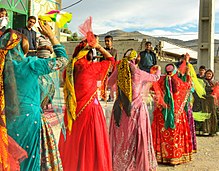The Lurs (Persian: لر) are an Iranian people living in western Iran. The four Luri branches are the Bakhtiari, Mamasani, Kohgiluyeh and Lur proper, who are principally linked by the Luri language.
 Dasmâl-bâzi dance, Mamasani, Iran | |
| Total population | |
|---|---|
| 5,000,000 | |
| Regions with significant populations | |
| |
| Languages | |
| Luri and Persian | |
| Religion | |
| Mainly Shia Islam; minority Sunni Islam and Yarsanism | |
| Related ethnic groups | |
| Other Iranian peoples | |
Lorestan province is named after the Lurs, but some Lurs live in other provinces including Fars, Chaharmahal and Bakhtiari, Kohgiluyeh and Boyer-Ahmad, Khuzestan, Hamadan, Isfahan, Tehran and southern Ilam Province.
History
Lurs are a mixture of aboriginal Iranian tribes, originating from Central Asia and the pre-Iranic tribes of western Iran, such as the Kassites (whose homeland appears to have been in what is now Lorestan) and Gutians. In accordance with geographical and archaeological matching, some historians argue that the Elamites were the Proto-Lurs, whose language became Iranian only in the Middle Ages. The distinctive characteristics of the Lur dialects imply that they were Iranized by Persis rather than Media.
The history of the Lurs is closely linked with the dynasties that ruled in Khuzestan, Shiraz, Isfahan, Hamadan and in the Zagros Mountains. The Buyid dynasty is known to have produced coins at Izeh. In 935, they marched their forces through Lorestan. The Karkheh River was later controlled by the Hasanwayhid dynasty, who used Sarmadj as their capital. In c. 1009, they conquered Shapur-Khwast (Khorramabad). In 1042, the Seljuk Empire besieged Shapur-Khwast, then ruled by the Kakuyid dynasty. Between 1152 and 1174/75, Lorestan and some of Khuzestan was controlled by a Turkic lord named Husam al-Din Shuhla. The tribal structure of the Lurs, whose development culminated with the arrival of the Atabegs, was unaffected by any outside attempts to conquer Lorestan or seize portions of its land.
The new Iranian monarch Reza Shah (r. 1925–1941) brought the Bakhtiari lands into the normal system of Iranian government, which included forcibly making semi-nomadic tribesmen settle. The semi-nomadic way of life that many Bakhtiaris and Lurs were familiar with, however, returned as a result of Reza Shah's toppling in 1941 and the period of less effective rule during the early years of Mohammad Reza Pahlavi's reign. In 1986, at the time of the publication of Vladimir Minorsky's entry on the Lurs in the 2nd edition of the Encyclopaedia of Islam, a sizeable portion of the Lurs and Bakhtiaris were still living that way of life.
Culture
The authority of tribal elders remains a strong influence among the nomadic population. It is not as dominant among the settled urban population. As among Kurds, Lur women have much greater freedom than women in other groups within the region. The women have more freedom to participate in different social activities, to wear diverse types of female clothing and to sing and dance in different ceremonies. Bibi Maryam Bakhtiari is a notable Luri woman. Luri music, Luri clothing and Luri folk dances are some of the most distinctive ethno-cultural characteristics of this ethnic group.
Many Lurs are small-scale agriculturists and shepherds. A few Lurs are also traveling musicians. Luri textiles and weaving skills are highly esteemed for their workmanship and beauty.
Religion
Most Lurs are Shia Muslim. Historically, many Lurs adhered to Yarsanism but almost the whole Yarsani Luri population has converted to Shia Islam. A small Sunni Muslim community of Lurs also exists. According to the Encyclopaedia of Islam, the Lurs revere bread and fire like the Zoroastrians. Recent reports also indicate a growing Zoroastrian religious movement, particularly among Bakhtiari Lurs.
Language
Luri is a Western Iranian language continuum spoken by about four million people. The continuum constitutes the three dialects of Bakhtiari, Luristani and Southern Luri which linguist Anonby situates between Kurdish and Persian.
Luri branches
There are several established branches of the Luri language.
- Bakhtiari
- Southern Lori
- Boyerahmadi (Yasuji)
- Kohgiluyei
- Mamasani
- Luristani (Northern Lori)
- Khorramabadi
- Borujerdi
- Bala Gariva Lori
- Hinimini
- Shuhani
Genetics
Considering their NRY variation, the Lurs are distinguished from other Iranian groups by their relatively elevated frequency of Y-DNA Haplogroup R1b (specifically, of subclade R1b1a2a-L23). Together with its other clades, the R1 group comprises the single most common haplogroup among the Lurs. Haplogroup J2a (subclades J2a3a-M47, J2a3b-M67, J2a3h-M530, more specifically) is the second most commonly occurring patrilineage in the Lurs and is associated with the diffusion of agriculturalists from the Neolithic Near East c. 8000-4000 BCE. Another haplogroup reaching a frequency above 10% is that of G2a, with subclade G2a3b accounting for most of this. Also significant is haplogroup E1b1b1a1b, for which the Lurs display the highest frequency in Iran. Lineages Q1b1 and Q1a3 present at 6%, and T at 4%.
See also
References
External links
- Amanolahi, Sekandar (2002). "Reza Shah and the Lurs: the Impact of the Modern State On Luristan". Iran and the Caucasus. 6 (1): 193–218. doi:10.1163/157338402X00124.
- Minorsky, V. (1986). "Lur". In Bosworth, C. E.; van Donzel, E.; Lewis, B. & Pellat, Ch. (eds.). The Encyclopaedia of Islam, Second Edition. Volume V: Khe–Mahi. Leiden: E. J. Brill. ISBN 978-90-04-07819-2.
- ""Luri" Carpet weaving style incorporating design themes of ancient Persia". JOZAN. Retrieved 2015-09-21.